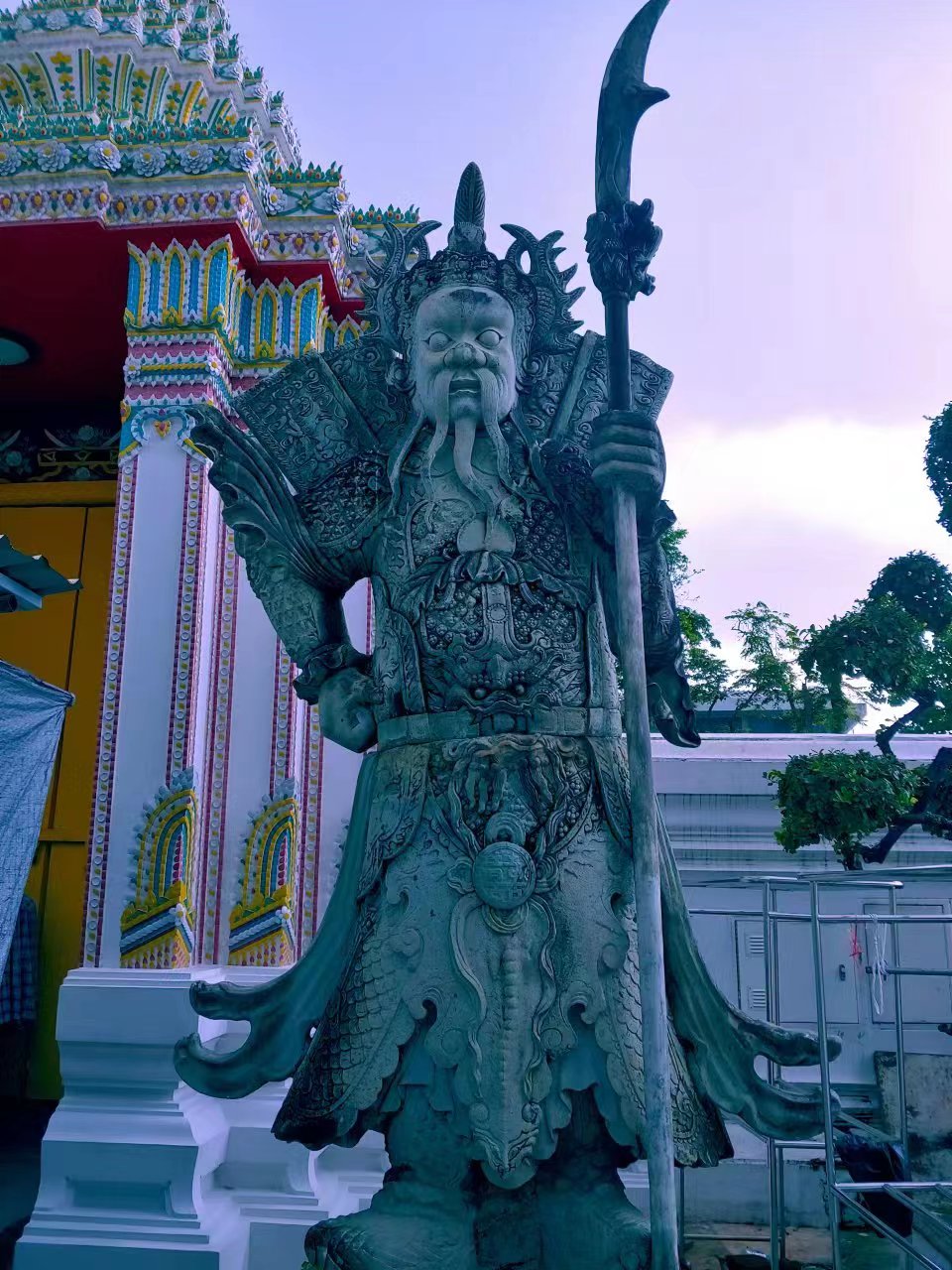Chinese culture in Thai temples
- By Mitchell Blatt
 0 Comment(s)
0 Comment(s) Print
Print E-mail China.org.cn, October 5, 2022
E-mail China.org.cn, October 5, 2022

The astonishing multitude of orange and green-tiled roof tiers at Wat Suthat tower above the humble visitor, and the shining glass ornaments catch the eye from far away.
The ornately-carved golden points extending from the bargeboard of the roof – those are called lamyong, and they evoke the form of the Nāga and Nāgi, the half-man, half-serpent children of the gods.
I just arrived in Thailand last week, and I still have a lot to learn about Thai Buddhism and Thai temples. But one thing that is very familiar to me in the yard of Wat Suthat is the long-bearded warrior wielding the Green Dragon Crescent Blade. It appears to me to be none other than Guanyu.
Images from Chinese legends and art are prevalent at Thai temples. Besides the apparent sighting of Guanyu, I have also seen other statues that look Chinese. The painting style of the murals on the walls of the temples also seems to have some kind of Chinese influence.
China and Thailand have had significant trade relations and cultural exchanges throughout history. In the 1400s, Zheng He navigated his treasure ships to Ayutthaya, the ancient Siamese kingdom that existed during the Ming and early Qing dynasties. The treasure ships brought with them statues and paintings that would be exchanged and put on display in temples. Trade missions would continue over the ensuing centuries.
Victor Lieberman, a prominent historian of Southeast Asia at the University of Michigan, wrote that the late 1600s and 1700s were, for Siam, a "period … of Chinese-assisted economic vitality that would continue into the 19th century." The population of ethnic Chinese in the kingdom also flourished during that time.

Temples would be designed with pieces taken from those with whom they traded. Aiken Unni, a student of Siamese and Southeast Asian art at the University of London's Courtauld Institute of Art, points to the glass paintings hanging high above worshippers in the main hall of Wat Pho. The paintings of junks sailing along the Guangzhou coast and phoenixes with red and blue feathers were produced in southern China and imported to Thailand during the golden age of the Ayutthaya.
Those renditions were drawn on paper and then traced with oil paint on glass. Because they could be produced rather efficiently, yet maintained an air of luxury, they were popular souvenirs.
"Historians believe that glass paintings, like ceramics and other Chinese goods, were used to indicate wealth and abundance," Unni wrote.
Other popular themes on display at temples are plants and animal life, the Legend of the Three Kingdoms, and seascapes. There is a reason for each of these depictions. The flora and fauna evoke the Himavanta, the magical wooded paradise of Buddhist lore. The bravery of the warriors and emperors battling to reclaim lost territory in Legend of the Three Kingdoms reflects the bravery of the Thai warriors and kings who had to fight back to reclaim land contested by Burmese and Khmer kingdoms. The junks represent how one's journey to enlightenment is similar to a ship's journey across the sea.
I visited Wat Pho and looked at the paintings high up on the wall and could identify the Chinese junk Unni pointed out in his article. It would have been easy to miss otherwise. I plan to talk to Unni next week and learn more about Thai temple art.
The stone statues of the Guanyu-like warriors, however, are impossible to miss. They stand guard next to almost every major doorway. They are protector warriors, imported from China, clearly inspired by Guanyu. Who better to protect a temple?
Thai artist Komkrit Tepthian noticed the similarities between the Chinese warrior and Thai culture's giant white nature-spirit Sahassa Deja and displayed them conjoined together at the 2018 Bangkok Art Biennale. Both "have the same role of guarding temples," Komkrit said at the time.
"King Rama II very much liked to bring in Chinese craftsmen … Back then, Thai and Chinese people were close like siblings."
Mitchell Blatt is a columnist with China.org.cn. For more information please visit:
http://www.china.org.cn/opinion/MitchellBlatt.htm
Opinion articles reflect the views of their authors, not necessarily those of China.org.cn.
If you would like to contribute, please contact us at opinion@china.org.cn.






Go to Forum >>0 Comment(s)